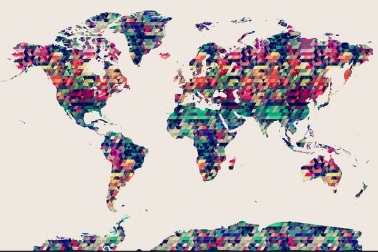English rules the world. Not in term of the most spoken language (that would be Mandarin Chinese, it seems), but in the business world, English is a must. We live in a world where we take for granted that everyone should speak at least a bit of English. The most used websites are in English, and many companies doing business in other countries do so in English. It is, after all, the lingua franca of our modern world. It hasn’t always be that way — French have been the language used in Monarchy for many centuries — and it certainly won’t always be that way — maybe Chinese in a few decades, who knows — but it is the case now.
 But even if your business partners speak English and your primary market is in countries where most people speak English, every business should take the time to think about their language and cultural strategy. After all, maybe the pond will become too small for you and you’ll have to seek some new market. This is where you should start thinking about your language strategy.
But even if your business partners speak English and your primary market is in countries where most people speak English, every business should take the time to think about their language and cultural strategy. After all, maybe the pond will become too small for you and you’ll have to seek some new market. This is where you should start thinking about your language strategy.
Language and culture
There are two major factors here: the language and the culture. These two factors must be considered both at the same time and on different level: people can speak different languages but share the same culture, speak the same language but have different culture; or the obvious one, speak different language and have different culture. The language strategy should also be on different level: inside the company if you are thinking about expanding and opening in other countries and outside the company, with the exchanges you have with the customers.
Inside the company
Let’s start with the things to consider inside the company. You are thinking about an expansion to open new market, maybe to open a factory in another country or maybe just a call center; maybe you want to open a whole new branch somewhere else; no matter what, you have to think about the language and culture of the place you want to go. Your strategy should asses that everyone is on the same page and shares the same goals to go forward despite the language or cultural barriers.
Breaking this language barrier implies having a workforce able to speak both languages: the original one (your language, maybe English for the purpose of this paper) and the target one. Of course, you don’t have to make everyone bilingual, but it is important to make sure you have a balance of people speaking both languages to make sure everyone is on the same page. More than the language, you also have to understand the culture of that country. Even if all your workers from the target country are perfectly speaking English, there can be some frictions created by a lack of cultural awareness. Your strategy should take these things into account too.
Of course, there are companies that choose to use only English as their language strategy, and this can be useful in some instance. But sharing different languages and cultures can help business in the long run and help create a corporate environment that feels more alive. People are more willing to share ideas or moments in their own maternal language, or at least in an environment where they feels their own culture is respected and appreciated.
The customer and his language
 There are numerous researches that show it: customers prefer service in their own language. If they have the choice between a company that can serve them only in English and one that speaks their language, more often than not they will choice the second one.
There are numerous researches that show it: customers prefer service in their own language. If they have the choice between a company that can serve them only in English and one that speaks their language, more often than not they will choice the second one.
One of these researches, by Vaerenbergh and Holmqvist in 2011, have find that “consumers are more likely to tip if served in their native language compared to when served in their second language. Moreover, this relationship is not dependent on consumers’ perceived second language proficiency, but rather upon their political considerations.” This study take a look on tipping behaviour, but this kind of thinking can be apply on a bigger scale. A big scale inquiry by Global Sense Advisory in 2006 showed that “more than half [their] sample (52.4%) buys only at websites where the information is presented in their language” and that “the vast majority (85.3%) of [their] respondents feels that having pre-purchase information in their own language is a critical factor in buying insurance and other financial services”. More studies more or less gives numbers of the same order, but you get the gist of it: speaking the customer language is a good way to get them to buy your product.
So, do businesses have to adapt their website and companies to all languages and culture in the world? Of course not, it is a matter of target market. But there is value to adapt them to a few key groups to make sure to join the groups that matter to you.
There is another factor not to forget in these day and age: the social media platforms. People mostly use social media platforms in their language, and this is a place companies often forget to use in the language of their target customers. More and more people pass most of their online life on these websites, or they get from the social media to the rest of Internet. A great language strategy shouldn’t forget the social media, the same way no big marketing campaign can forget them nowadays.
The agents of a good language strategy
Where do you need to look for your language strategy? There are a few players that can help you in this process. There are advisory companies specialized on the question of corporate strategy. You can hire consultants on that matter, or even have someone inside the house to handle all your language and culture matters.
 Of course, when the time comes to make the transition in another language, a good translator (or even a team of translator) is a must. He must be able to localize the material you need and to adapt some of it to the target market. But beware of the appeal of automatized translation software and other computer only translation material: they aren’t that reliable yet. Nothing beats a real human being, and customers can see the difference between a good translation and a botched one.
Of course, when the time comes to make the transition in another language, a good translator (or even a team of translator) is a must. He must be able to localize the material you need and to adapt some of it to the target market. But beware of the appeal of automatized translation software and other computer only translation material: they aren’t that reliable yet. Nothing beats a real human being, and customers can see the difference between a good translation and a botched one.
And you have to also be one of the principal agents of the strategy. A good strategy is made by all the important actors, and act accordingly. Look at your business goal on short, middle and long term; look at some potential market to tackle and think outside the box. And of course, stay curious and respect your customer. There is so much to learn from the point of view of other, and what better way to do it than by the language road?
Bibliography and further reading
–Author Unknow –,The Business Value of Communication in Native Languages for Sales & Customer Care, document prepared by WhalePath in 2014 for LTI – Language Testing International (online, consulted the 24th of January 2017)
–Author Unknow- Language Means Business, a study by Rosetta Stone, published online (PDF) on April 2013. (View on January 24th 2017)
Camerota, Christian. Why Global Businesses need a Language Strategy, Forbes website, published online in October 2014. (View on January 24th 2017)
De Palma and all. Can’t Read, Won’t Buy: Why Language Matters, survey by Common Sense Advisory, 2006. (excerpt available for everyone; the whole documents available to customers of Common Sens Advisory only)
Howes, David and all. Cross-Cultural Consumption – Global Market, Local Realities, Rootledge 2014, first edition 1996, London, 220 p.
Janssens et all. Developing language strategies for international companies: the contribution of translation studies, Journal of World Business, vol. 39 issue 4, p. 414-430.
Kelly, Nataly. Speak to Global Customers in Their Own Language, Harvard Business Review, published in 2014, online. (View on January 23th 2017)
Kaplan, Steven and Neeley, Tsedal. What’s your Language Strategy?, Harvard Business Review, published online in September 2014. (View on January 24th 2017)
Shantz, Celeste. Four Crucial Steps When Developing a Language Strategy, Language Intelligence, posted March 12th 2015, online. (View on January 23th 2017)
Vaerenbergh, Yves Van and Homqvist, Jonas. Speak my language if you want my money – Service language’s influence on tipping behaviour, European Journal of Marketing, vol. 47, no.8, 2013pp. 1276-1292.



 ils s’emboîtent les uns dans les autres. Une bonne traduction peut contenir quelques éléments de localisation; une bonne localisation passe essentiellement par une bonne traduction; la globalisation et l’internationalisation peuvent nécessiter des traductions et de la localisations; une campagne pour un produit international demander une trans-création dans certains marchés… Un bon traducteur doit donc savoir jongler avec ces concepts afin de pouvoir répondre aux besoins de son client. Un client qui demande de traduire un site Internet qui s’adresse à toute la francophonie demande une forme de globalisation: le français utilisé différera d’un site Internet qui s’adresse à l’Amérique du nord francophone, d’un site qui s’adresse principalement à des Suisses francophones ou à seulement des Québécois. Le traducteur doit donc s’assurer de bien choisir les termes, les références, les idiomes, etc. pour s’assurer d’être compris de la même manière partout dans la francophonie. Une oeuvre littéraire bien traduite doit garder l’identité et la culture de la langue de départ, mais on ne doit pas avoir l’impression de lire une traduction. Certaines blagues peuvent nécessiter des changements, certains noms être traduits, etc. Et le public cible peut aussi changer le type de traduction: il va de soit qu’on ne traduit pas un roman jeunesse (qu’on localise parfois bien plus) comme une oeuvre littéraire majeure.
ils s’emboîtent les uns dans les autres. Une bonne traduction peut contenir quelques éléments de localisation; une bonne localisation passe essentiellement par une bonne traduction; la globalisation et l’internationalisation peuvent nécessiter des traductions et de la localisations; une campagne pour un produit international demander une trans-création dans certains marchés… Un bon traducteur doit donc savoir jongler avec ces concepts afin de pouvoir répondre aux besoins de son client. Un client qui demande de traduire un site Internet qui s’adresse à toute la francophonie demande une forme de globalisation: le français utilisé différera d’un site Internet qui s’adresse à l’Amérique du nord francophone, d’un site qui s’adresse principalement à des Suisses francophones ou à seulement des Québécois. Le traducteur doit donc s’assurer de bien choisir les termes, les références, les idiomes, etc. pour s’assurer d’être compris de la même manière partout dans la francophonie. Une oeuvre littéraire bien traduite doit garder l’identité et la culture de la langue de départ, mais on ne doit pas avoir l’impression de lire une traduction. Certaines blagues peuvent nécessiter des changements, certains noms être traduits, etc. Et le public cible peut aussi changer le type de traduction: il va de soit qu’on ne traduit pas un roman jeunesse (qu’on localise parfois bien plus) comme une oeuvre littéraire majeure.